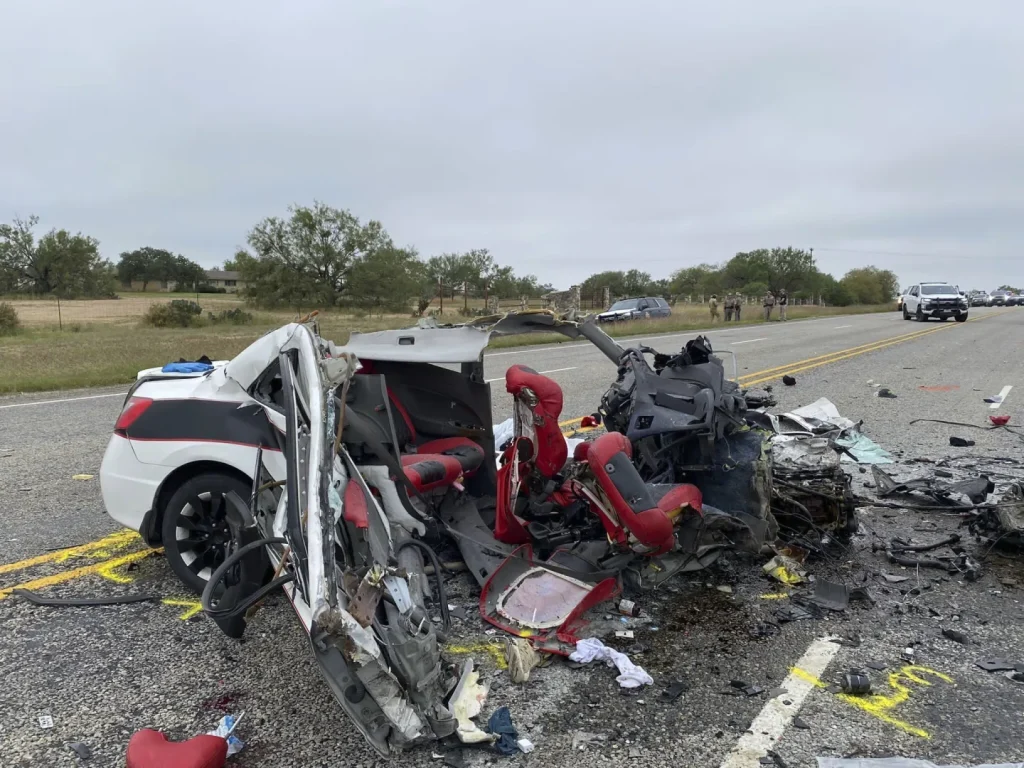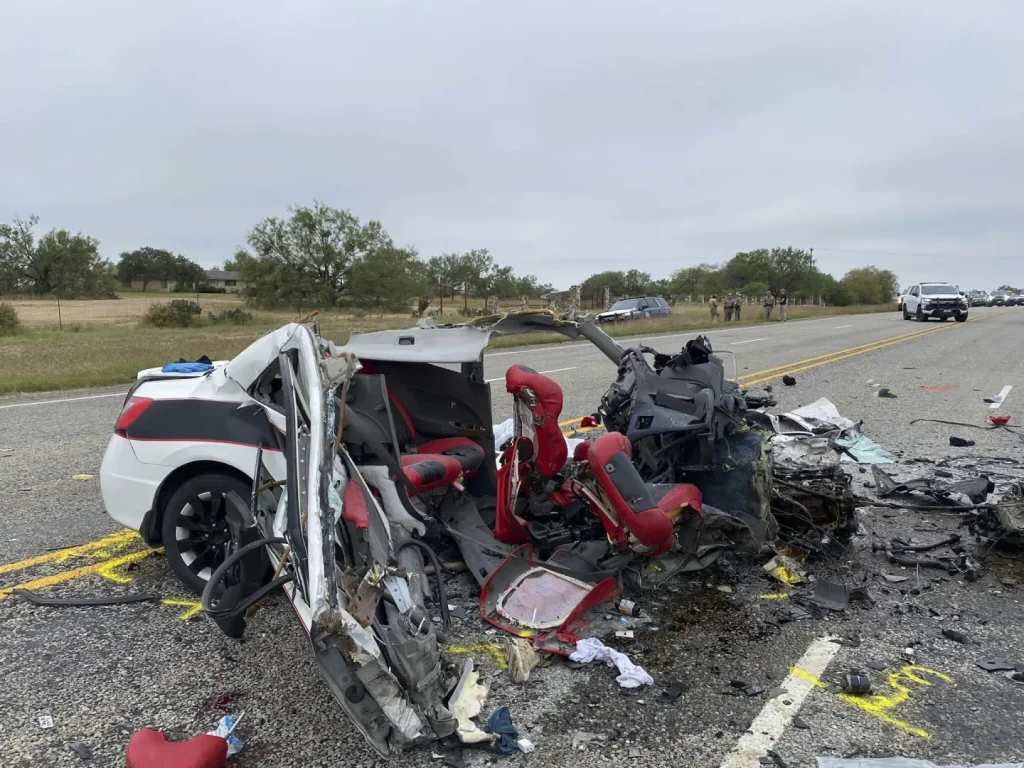The recent tragic incident on Highway 57 near La Pryor, Texas, has once again brought to light the dangers of high-speed pursuits, particularly in the context of the ever-increasing law enforcement presence at the U.S.-Mexico border.
The pursuit of migrants and suspected smugglers has become a routine occurrence in Texas, with the aim of curbing the flow of illegal immigration and drug trafficking.
However, the devastating consequences of such pursuits were starkly evident in the aftermath of the fatal head-on crash that claimed the lives of eight individuals, including Honduran citizens and residents of Georgia.
The mangled wreckage at the scene serves as a poignant reminder of the inherent risks associated with high-speed chases, not only for the individuals being pursued but also for innocent bystanders.
As the state of Texas continues to deploy additional troopers and law enforcement personnel to the border region, it is imperative that the potential hazards of these pursuits are carefully weighed against the intended objectives of border security and public safety.
This tragic incident underscores the need for a thorough reevaluation of pursuit protocols and the implementation of measures to minimize the risk of such catastrophic outcomes in the future.
The recent crash has sparked renewed criticism surrounding the speed and duration of police pursuits. Many are questioning whether these pursuits are too fast and whether they are allowed to continue for too long, especially in cases where the chase has resulted in injuries or even death.
This has brought to light the need for a reevaluation of pursuit policies and procedures. In response to these concerns, U.S. Customs and Border Protection has implemented a new policy for vehicle pursuits, with a focus on increasing safety for all involved.
This new policy aims to address the criticisms and mitigate the risks associated with high-speed pursuits. It is crucial for law enforcement agencies to prioritize the safety of both officers and civilians while still effectively carrying out their duties.
The implementation of this new policy is a step in the right direction towards achieving this balance.
The issue of high-speed pursuits and the tragic consequences that often result from them continue to be a cause for concern for many individuals.
David Stout, a county commissioner in El Paso, expressed his belief that more needs to be done to prevent these dangerous situations from occurring.
He highlighted the alarming number of high-speed pursuits that have taken place in his border county, with over 500 incidents already this year, many of which reached speeds exceeding 100 mph.
The recent collision between a Honda Civic and a Chevrolet Equinox, resulting in the deaths of the occupants of both vehicles, serves as a grim reminder of the potential dangers associated with high-speed chases.
Despite the severity of the situation, the identities of the victims have yet to be released, leaving many questions unanswered. It is clear that there is a pressing need for further action to address this issue and prevent further loss of life.
The top speeds reached during the pursuit that began when a Zavala County sheriff’s deputy attempted to pull over a Civic around dawn remain unclear.
The sheriff’s office has provided only a brief report and did not comment further on the matter. The crash is currently under investigation by the Texas Department of Public Safety, which is responsible for overseeing Governor Greg Abbott’s border mission, Operation Lone Star.
While the department did not immediately provide figures on high-speed pursuits, Director Steve McCraw did acknowledge that his troopers have been involved in thousands of chases over the past two years.
According to McCraw, a pursuit can be called off if it poses an unreasonable risk to the public or the officers involved. Additionally, troopers will back off if police aircraft are deployed to monitor the fleeing vehicle.
However, McCraw noted that even when troopers disengage, the suspects often continue to drive at high speeds, making the situation challenging to manage.
This issue has raised concerns among civil rights groups, with the American Civil Liberties Union and others filing a complaint with the U.S. Justice Department over high-speed pursuits along the Texas border.
According to the groups, there have been 30 deaths and 71 injuries in chases involving state troopers during the first 16 months of Abbott’s border mission, as reported in various news outlets.
Pedro Rios, a distinguished director of the American Friends Service Committee, has meticulously examined the policies governing federal agents engaged in vehicular pursuits and has arrived at the resolute conclusion that such chases should be categorically prohibited.
“What we’ve called for is an end to vehicle pursuits because the peril posed not only to migrants, but also to the officers or agents involved, as well as to other innocent bystanders, as evidenced in this particular case, is simply untenable,” he stated.
The tragic Texas crash stands as a grim testament, marking the highest death toll in a collision involving migrants since 13 individuals perished in a remote Holtville, California incident in March 2021.
Moreover, another harrowing pursuit by local law enforcement near the Texas border culminated in the heartbreaking loss of four migrants just last year.
Commissioner McCraw, in response, affirmed that he has never terminated a trooper over their actions during a pursuit, indicating, “I’m certain that we’ve provided some form of guidance or counseling.
That is simply a natural occurrence due to the delicate balance between the speed at which one drives and the potential risk involved.
At times, the risk may not solely be to the public, but also to the trooper hurtling down the roadway at 153 miles per hour.”
These deeply troubling incidents underscore the urgent need for a comprehensive reevaluation of pursuit protocols and a reinvigorated commitment to safeguarding the lives of all individuals involved.
In El Paso, the occurrence of high-speed pursuits has led to a significant increase in the number of accidents this year, with more than 60 reported so far.
One particularly tragic incident that stands out in the memory of law enforcement officials is a chase that ended with a car crashing on a bridge.
The aftermath of this harrowing event was nothing short of devastating, as two migrants who were inside the car at the time of the crash tragically lost their lives after falling from the bridge.
The gravity of this situation serves as a stark reminder of the potential dangers and consequences that can arise from high-speed pursuits.
It also underscores the need for law enforcement agencies to carefully assess the risks and weigh the potential outcomes before engaging in such pursuits, in order to prevent further loss of life and minimize the impact on the community.
The tragic outcome of this particular chase serves as a sobering reminder of the need for caution and prudence in law enforcement operations, and highlights the importance of prioritizing public safety above all else.
The statement “That really sticks out in my mind when I think about these things,” reflects the speaker’s strong impression of a particular event or memory.
The use of the phrase “sticks out in my mind” suggests that the memory is vivid and prominent, and it has left a lasting impact on the speaker.
This expression also indicates that the memory is easily recalled and stands out among other thoughts or recollections. The speaker’s use of the phrase “when I think about these things” further emphasizes the significance of the memory within a specific context or set of circumstances.
Overall, the statement conveys a sense of importance and significance attached to the memory, and it suggests that the speaker holds this particular recollection in high regard.
It is truly disheartening to hear about the high number of accidents resulting from high-speed pursuits in El Paso. As reported, the figure has exceeded 60 accidents, which is a cause for concern.
The statement made by Stout, who is responsible for overseeing the police department, highlights the gravity of the situation.
He recalls a particular chase that ended in a tragic accident, where two migrants lost their lives. The incident is etched in his memory and serves as a reminder of the devastating consequences of such pursuits.
It is evident that high-speed pursuits pose a significant risk to the public and law enforcement officers. The potential for accidents resulting in severe injuries or fatalities is high, and the consequences can be devastating.

The incident that Stout mentioned is a prime example of the terrible outcomes that can occur from such pursuits. It is essential to weigh the risks and benefits of these pursuits and consider the safety of all parties involved.
While it is understandable that law enforcement officers may feel the need to engage in high-speed pursuits to apprehend suspects, it is crucial to evaluate the situation and determine if the chase is worth the risk.
In some cases, it may be more prudent to discontinue the pursuit and find alternative methods to apprehend the suspect. It is crucial to prioritize the safety of the public, law enforcement officers, and the suspects involved.
In conclusion, the high number of accidents resulting from high-speed pursuits in El Paso is a cause for concern. The tragic incident that Stout mentioned is a sobering reminder of the devastating consequences of such pursuits.
It is essential to evaluate the risks and benefits of these pursuits and prioritize the safety of all parties involved. We must work towards finding alternative methods to apprehend suspects and reduce the risks associated with high-speed pursuits.
